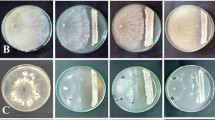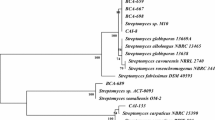Abstract
Thirty isolates of Streptomyces like colony isolated from vermicompost soils were assessed for their antagonistic and plant growth-promoting (PGP) activities. Five isolates having the best inhibitory activity against five plant pathogenic fungi, Colletotrichum gloeosporioides, C. musae, Fusarium sp. TFPK201, Fusarium sp. Foc 1699 and Pestalotia sp. were subsequently identified by 16S rDNA analysis. The selected isolates were classified in the genus Streptomyces and given the name of Streptomyces spp. SEF1, SEF8, SEF47, SEF48 and SEF49, respectively. Then, their PGP and antifungal activities were evaluated. The results showed that the selected isolates were able to produce IAA, siderophore, and amylase. Production of IAA was ranged from 14.06 to 16.59 µg/mL. The highest siderophore production was found in the isolate SEF48. Only isolates SEF47, SEF48, and SEF49 showed amylolytic activity. The culture filtrate from the tested Streptomyces spp. inhibited the fungal mycelial growth and suppressed conidial germination, but their inhibition ability was different. Interestingly, the application of all selected culture filtrates before disease infection significantly decreased tomato Fusarium wilt disease incidence and severity. However, only Streptomyces sp. SEF47 could significantly reduce the disease incidence and severity when it was applied after the disease infection. Moreover, this research found the plant growth-promoting ability of the culture filtrate of selected isolates on tested tomatoes. The Streptomyces sp. SEF47 provided a significant ability for controlling all tested plant pathogenic fungi and promoting plant growth. Therefore, Streptomyces sp. SEF47 could be considerable biocontrol and PGP agent used in sustainable agriculture.

Similar content being viewed by others
References
Abbasi S, Safaie N, Sadeghi A, Shamsbakhsh M (2019) Streptomyces strains induce resistance to Fusarium oxysporum f.sp. lycopersici race 3 in tomato through different molecular mechanisms. Front Microbiol. https://doi.org/10.3389/fmicb.2019.01505
Adams PB (1990) The potential of mycoparasites for biological control of plant diseases. Annu Rev Phytopathol 28:59–72
Alam M, Dharni S, Khaliq A, Srivastava SK, Samad A, Gupta MK (2012) A promising strain of Streptomyces sp. with agricultural traits for growth promotion and disease management. Indian J Exp Biol 50:559–568
Aldesuquy HS, Mansour FA, Abo-Hamed SA (1998) Effect of the culture filtrate of Streptomyces on growth and productivity of wheat plants. Folia Microbiol 43:465–470
Bano N, Musarrat J (2003) Characterization of a new Pseudomonas aeruginosa strain NJ-15 as a potential biocontrol agent. Curr Microbiol 46:324–328
Chen Y, Zhou D, Qi D, Gao Z, Xie J, Luo Y (2018) Growth promotion and disease suppression ability of a Streptomyces sp. CB-75 from banana rhizosphere soil. Front Microbiol. https://doi.org/10.3389/fmicb2017.02704
Cross T (1989) Growth and examination of Actinomycetes some guidelines. Bergey’s Manual of Systematic Bacteriology. Williams and Wilkins Company, Baltimore, vol 4, pp 2340–2343
De Wolf E, Effertz R, Ali S, Francl L (1998) Vistas of tan spot research. Can J Plant Pathol 20:349–370
Elango V, Manjukarunambika K, Ponmurugan P, Marimuthu S (2015) Evaluation of Streptomyces spp. for effective management of Poria hypolateritia causing red root-rot disease in tea plants. Biol Control 89:75–83
El-Tarabily KA, Nassar AH, Hardy GE, Sivasithamparam K (2009) Plant growth promotion and biological control of Pythium aphanidermatum, a pathogen of cucumber, by endophytic actinomycetes. J Appl Microbiol 106:13–26
Etebarian HR (2006) Evaluation of Streptomyces strains for biological control of charcoal stem rot of melon caused by Macrophomina phaseolina. Plant Pathol J 5(1):83–87
Evangelista-Martínez Z (2014) Isolation and characterization of soil Streptomyces species as potential biological control agents against fungal plant pathogens. World J Microb Biot 30:1639–1647
Glick BR, Todorovic B, Czarny J, Cheng Z, Duan J, McConkey B (2007) Promotion of plant growth by bacterial ACC deaminase. Crit Rev Plant Sci 26:227–242
Gohel V, Singh A, Vimal M, Ashwini P, Chhatpar HS (2006) Bioprospecting and antifungal potential of chitinolytic microorganisms. Afr J Biotechnol 5:54–72
Gopalakrishnan S, Vadlamudi S, Bandikinda P, Sathya A, Vijayabharathi R, Rupela O, Kudapa H, Katta K, Varshney RK (2014) Evaluation of Streptomyces strains isolated from herbal vermicompost for their plant growth-promotion traits in rice. Microbiol Res 169:40–48
Hamdali H, Hafidi M, Virolle MJ, Ouhdouch Y (2008) Rock phosphate-solubilizing Actinomycetes: screening for plant growth-promoting activities. World J Microb Biot 24:2565–2575
Hao D, Gao P, Liu P, Zhao J, Wang Y, Yang W, Lu Y, Shi T, Zhang X (2011) AC3-33 a novel secretory protein, inhibits Elk1 transcriptional activity via ERK pathway. Mol Biol Rep 38:1375–1382
Heng JLS, Shah UKM, Rahman NAA, Shaari K, Hamzah H (2015) Streptomyces ambofaciens S2—a potential biological control agent for Colletotrichum gleosporioides the causal agent for anthracnose in red chilli fruits. J Plant Pathol Microbiol S 2015:1. https://doi.org/10.4172/2157-7471.s1-006
Jolanta S, Joanna Z, Magdalena P, Aleksandra R (2012) Biologically active secondary metabolites from Actinomycetes. Cent Eur J Biol 7:373–390
Joo GJ (2005) Production of an antifungal substance for biological control of Phyophthora capsici causing phytophthora blight in red-peppers by Streptomyces halstedii. Biotechnol Lett 27:201–205
Kamal R, Sharma AK (2014) Control of Fusarium wilt using biological agent Streptomyces sp. CPP-53 isolated from compost with plant growth promoting effect on tomato under greenhouse condition. J Microbiol Antimicrob 6(6):97–103
Kaur T, Vasudev A, Sohal SK, Manhas RK (2014) Insecticidal and growth inhibitory potential of Streptomyces hydrogenans DH16 on major pest of India, Spodoptera litura (Fab.) (Lepidoptera: Noctuidae). BMC Microbiol 14:227. https://doi.org/10.1186/s12866-014-0227-1
Khamna S, Yokota A, Peberdy JF, Lumyong S (2010) Indole-3- Acetic production by Streptomyces sp. isolated from some Thai medicinal plant rhizosphere soils. Eurasia J Biosci 4:23–32
Kumar AS, Eswara Reddy NP, Hariprasad Reddy K, Charitha Devi M (2007) Evaluation of fungicidal resistance among Colletotrichum gloeosporioides isolates causing mango anthracnose in agri export zone of Andhra Pradesh, India. Plant Pathol Bull 16:157–160
Kwak YK, Kim IS, Cho MC, Lee SC, Kim S (2012) Growth inhibition effect of environment-friendly farm materials in Colletotrichum acutatum in vitro. J Bio-Environ Control 21:127–133
Lee EJ, Ahn YJ, Lee HS, Chung N (2012) Biocontrol of pepper anthracnose by a new Streptomyces sp. A1022 under greenhouse condition. J Korean Soc Appl Bi. 55:447–449
Li Q, Ning P, Zheng L, Huang J, Li G, Hsiang T (2012) Effects of volatile substances of Streptomyces globisporus JK-1 on control ob Botrytis cinerea on tomato fruit. Biol Control 61:113–120
Marlatt ML, Correll JC, Kaufmann P, Cooper PE (1996) Two genetically distinct populations of Fusarum oxysporum f. sp. lycopersici race 3 in the United States. Plant Dis 80:1342–1366
Minh NV, Woo E-E, Kim J-Y, Kim D-W, Hwang BS, Lee Y-J, Lee I-K, Yun B-S (2015) Antifungal substances from Streptomyces sp. A3265 antagonistic to plant pathogenic fungi. Mycobiology 43(3):333–338
Montesinos E (2003) Development, registration and commercialization of microbial pesticides for plant protection. Int Microbiol 6:245–252
Ouhdouch Y, Barakate M, Finance C (2001) Actinomycetes of Moroccan habitats: isolation and screening for antifungal activities. Eur J Soil Biol 37:69–74
Panhwar QA, Othman R, Rahman ZA, Meon S, Ismail MR (2012) Isolation and characterization of phosphate-solubilizing bacteria from aerobic rice. Afr J Biotechnol 11:2711–2719
Passari AK, Mishra VK, Gupta VK, Yadav MK, Saikia R, Singh BP (2015) In vitro and in vivo plant growth promoting activities and DNA fingerprinting of antagonistic endophytic actinomycetes associates with medicinal plants. PLoS ONE. https://doi.org/10.1371/journal.pone.0139468
Phukan I, Madhab M, Bordoloi M, Sarmah SR, Dutta P, Begum R, Tanti A, Bora S, Nair SC, Rai S, Debnath S, Barthakur BK (2012) Exploitation of PGP microbes of tea for improvement of plant growth and pest suppression: a novel approach. Two Bud 59:69–74
Sabaratnam S, Traquair JA (2002) Formulation of a Streptomyces biocontrol agent for the suppression of Rhizoctonia damping-off in tomato transplants. Biol Control 23:245–253
Sangdee A, Kornphachara S, Srisawat N (2016) In vitro screening of antagonistic activity of soil Streptomyces against plant pathogenic fungi andassessment of its characters. J Agri Tech 12(1):173–85
Schwyn B, Neilands JB (1987) Universal chemical assay for the detection and determination of siderophores. Anal Biochem 160:47–56
Shrivastava P, Kumar R, Yandigeri MS (2017) In vitro biocontrol activity of halotolerant Streptomyces aureofaciens K20: a potent antagonist against Macrophomina phaseolina (Tassi) Goid. Saudi J Biol Sci 24:192–199
Siddiqui ZA (2005) PGPR: Prospective biocontrol agents of plant pathogens. In: Siddiqui ZA (ed) PGPR: biocontrol and biofertilization. Springer, The Netherlands, pp 111–142
Sreevidya M, Gopalakrishnan S, Kudapa H, Varshney RK (2016) Exploring plant growth-promotion actinomycetes from vermicompost and rhizosphere soil for yield enhancement in chickpea. Braz J Microbiol 47:85–95
Suprapta DN (2012) Potential of microbial antagonists as biocontrol agents against plant fungal pathogens. JISSAAS 18:1–8
Taechowisan T, Lu C, Shen Y, Lumyong S (2005) Secondary metabolites from endophytic Streptomyces aureofaciens CMUAc130 and their antifungal activity. Microbiol 151:1691–1695
Tamura K, Stecher G, Peterson D, Filipski A, Kumar S (2013) MEGA6: molecular evolutionary genetics analysis version 6.0. Mol Biol Evol 30(12):2725–2729
Trejo-Estrada SR, Paszczynski A, Crawford DL (1998) Antibiotics and enzymes produced by the biocontrol agent Streptomyces violaceusniger YCED9. J Ind Microbiol Biotechnol 21:81–90
Verma VC, Singh SK, Prakash S (2012) Bio-control and plant growth promotion potential of siderophore producing endophytic Streptomyces from Azadirachta indica A. Juss. J Basic Microbiol 51:550–556
Wang Y, Brown HN, Crowley DE, Szaniszlo PJ (1993) Evidence for direct utilization of a siderophore, ferrioxamine B, in axenically grown cucumber. Plant Cell Environ 16:579–585
Weisburg ST, Goodfellow M, Wellington EMH, Vickers JC, Alderson G, Sneath PHA, Sackin MJ, Mortimer AM (1991) 16S ribosomal DNA amplification for phylogenetic study. J Bacteriol 173:697–703
ŽivkoviĆ S, StojanoviĆ S, IvanoviĆ Ž, GavriloviĆ V, PopoviĆ T, BalaŽ J (2010) Screening of antagonistic activity of microorganisms against Colletotrichum acutatum and Colletotrichum gloeosporioides. Arch Biol Sci Belgrade 62(3):611–623
Acknowledgements
The authors express their thanks to the Department of Agriculture and Resources, Faculty of Natural Resources and Agro-Industry, Kasetsart University Chalermphrakiat Sakon Nakhon Province Campus as well as Mahasarakham University Faculty of Science and Khon Kaen University Faculty of Agriculture for supporting equipment and space for this study.
Author information
Authors and Affiliations
Contributions
AS, PK, and AW designed, performed, and analyzed the experimental data. AL, WC, and WS performed experiments. AW critical proofed the data and manuscript. PK and AS wrote the manuscript.
Corresponding author
Ethics declarations
Conflict of interest
The authors declare that they do not have any conflict of interest.
Additional information
Publisher's Note
Springer Nature remains neutral with regard to jurisdictional claims in published maps and institutional affiliations.
Rights and permissions
About this article
Cite this article
Kawicha, P., Laopha, A., Chamnansing, W. et al. Biocontrol and plant growth-promoting properties of Streptomyces isolated from vermicompost soil. Indian Phytopathology 73, 655–666 (2020). https://doi.org/10.1007/s42360-020-00267-2
Received:
Revised:
Accepted:
Published:
Issue Date:
DOI: https://doi.org/10.1007/s42360-020-00267-2




